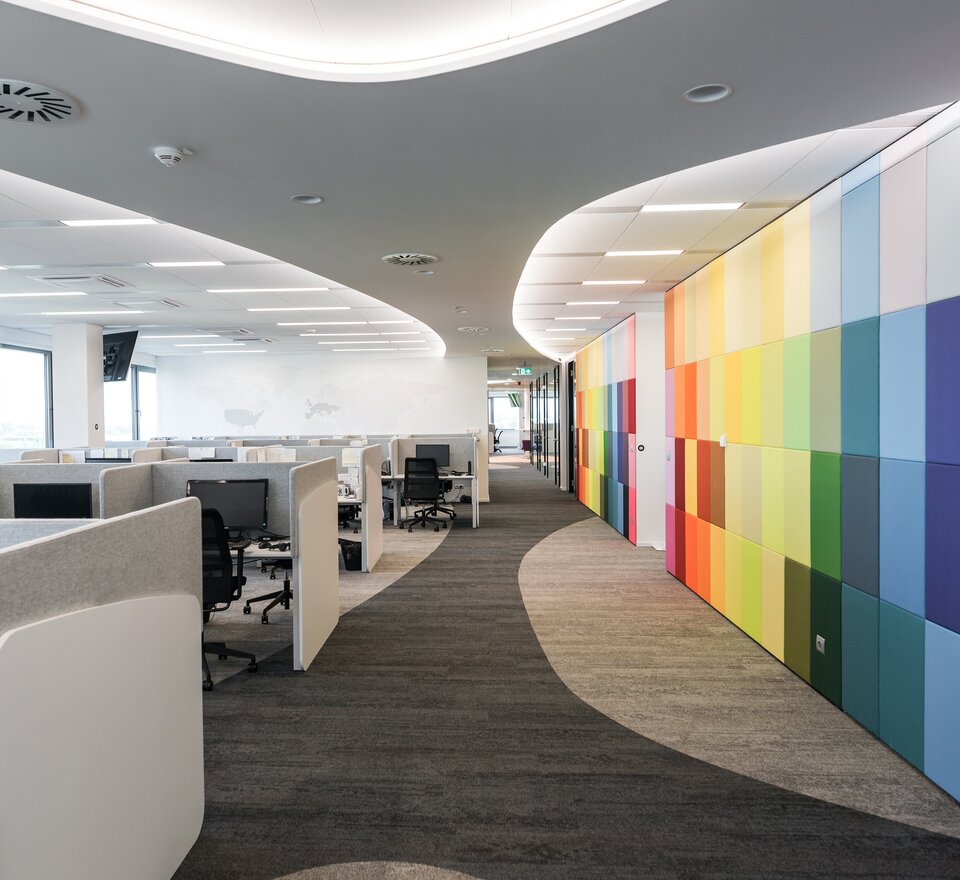The living room impresses with soft green tones which remind you of ripe olives. The kitchen has a lively feel thanks to red wooden chairs. And in the bathroom, dark blue bath towels and candles break up the white surroundings. Only the office seems sad – almost lifeless, thanks to the grey-beige monotony.
In living quarters, the targeted use of colour has always had a great significance, because colours stimulate our mood and influence the visual climate. We spend more time at our workspace than in our living room, which is why it is just as important to think about the use of colour here: who is motivated to work productively by a bleak, drab office appearance? If we look at it the other way round: who feels balanced and calm if an office immersed in neon colours reminds you more of a disco? “The main task of good office architecture is to bring people, function, space and furnishings into a common context. This is why good interior architecture strives for a gentle balance between a low level of stimulation and an overload of stimulation,” says Helga Eigner, interior architect at Office Consulter Roomware.
Colour, light and space in sync.
For the beneficial effect of colours to develop, the colours and areas must be brought into the right proportions. A large, drab area is just as stressful for our eyes as a brightly coloured area. In nature, there are no larger homogeneous areas. Even a meadow is a mixture of many different shades of green. So, if there is too little or too much stimulation for our eyes, this can lead to problems with concentration, headaches and even to visual impairment.
A vigilance study at the University of Vienna determined during a check of the error rate during sustained attention that colourful stimuli significantly increases concentration levels. Rooms without colour or rooms which were too bright increased the error rate among the test subjects. According to the study, a colour balance which generates a balanced level of tension would be the best for the eyes and the head. Light plays just as important a role in the selection of colour as the function of the room itself. Helga Eigner explains: “Colour is perceived in different ways depending on the type of light source. Surfaces which have a pleasant colouring in daylight can look completely different in yellowish overhead light.” The use of the room should be decisive for the colour selection: the design of communication rooms may be more open for bolder colour concepts than working rooms which are permanently occupied. Here, colour should only be used as an accent.
Tastes are known to be very different, yet the influence of colours on people is not a question of personal taste, rather an objective theory of the psychological effect of colour. This is why there are definite applications for certain colours which we utilise in an office environment.
Warm or cold? What colour should you have for the office?
- Red isn’t used as a signal colour for nothing. It gets our attention in an instant. We associate it with danger, as well as with love and passion. In its pure form, red should only be used for accents, above all in rooms which should encourage communication.
- Blue is a cold colour and reminds us of the vastness of the sea or sky. It increases our ability to concentrate and has a calming effect. A blue pin-board, a blue picture or a blue desktop wallpaper are options for breathing new life into everyday office life.
- Yellow is the purest colour, apart from white. It radiates cheerfulness and liveliness. It is best suited to reception areas and working cafes, as well as for places where people want to relax.
- With its earthy effect, brown is primarily suited to flooring. Brown provides stability.
- Green is a mixed colour and can assume many shades and facets. It represents growth and reminds us of nature. Like yellow, it is used for a cosier atmosphere, but also in rooms which were designed for concentrated working. Nature and colour can be integrated into the room design using room plants.
- Orange is also a mixed colour and assumes the properties of red – signal colour – and yellow – cheerfulness. Used in communication and conference rooms, it combines the concentration and attention of the participant.
- White is a non-colour and is associated with purity, above all. It should be avoided as a homogeneous colour on larger surfaces. White or bright tables remind us of a blank sheet of paper and focus our concentration on the current activity. Here, you must ensure that the surface is matt and not reflective.

